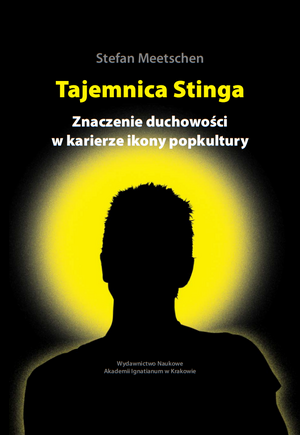Tajemnica Stinga: Znaczenie Duchowości W Karierze Ikony Popkultury
| Tajemnica Stinga: Znaczenie Duchowości W Karierze Ikony Popkultury | |
|---|---|
| Author: | Stefan Meetschen |
| Country: | Poland |
| Language: | Polish |
| Publisher: | Wydawnictwo Naukowe Akademii Ignatianum w Krakowie |
| Publication date: | 2023-05-12 |
| ISBN: | 978-83-7614-536-5 |
Contents
Introduction
The title of this 384 page paperback book (without photos) translates as "The Mystery of Sting: The Role Spirituality Plays in the Career of a Popular Icon".
Based on Émile Durkheim’s studies of religion, this work examines the cult of the British rock star Sting, alias Gordon Matthew Thomas Sumner. In doing so, Sting is treated as a totem that practices a complex exchange of energy with his admirers, complementing the findings of star research. The dogmas of this cult, which are proclaimed lyrically and through the media, are elaborated in detail and play an important role as offers of meaning for the identity and self-esteem processes of the followers. Rituals and myths that are part of Sting’s production are presented as essential components of the cult. Furthermore, the musical and creative techniques used by Sting are elaborated with a focus on inspiration.
In accordance with the hybrid-postmodern-alchemical approach of his music, Sting ideologically represents a syncretic-spiritual system that is characterised by esoteric contents and practices that were suppressed during the time of Christian cultural hegemony (“rejected knowledge”) and can be assigned in their totality to “Western Esotericism” (Wouter J. Hanegraaff) and the New Age. This system fits well with pop and rock culture, which emerged from the counterculture of the 1960s, is based primarily on transgressions, and was also marginalised by a dominant culture. By popularising “rejected knowledge” and phenomena of “occulture” (Christopher Partridge), Sting contributes to the re-enchantment of the “secular age” (Charles Taylor). From the profane “Sex, Drugs and Rock ‘n’ Roll”, Sting has created the sublime triad of Tantra Sex, Spiritual Drugs and Postmodern Music Eclecticism.
In the context of Durkheim’s predicted cult of individualism, which largely coincides with Nietzsche’s “God is dead” prediction and seems to have been fulfilled in the era of postmodernism, the “totem Sting” functions as an ideal role model for contemporary people who try to generate their own cosmos of values around their own self, without the help of religious institutions. Sting succeeds in this through an authentic-looking self-realisation, a seemingly limitless artistic and spiritual totality that he successfully represents (private religion) as well as an almost symbolic existence. In this (and in other points) he resembles Johann Wolfgang von Goethe, who was classified by Nietzsche as the “overman” of the future and is still cultically revered today (anthroposophists etc.). The equivalent of Goethe in the context of popular culture and beyond is, from the late 1970s onwards, Sting. If one goes back to C.G. Jung’s popular archetype model, the effect of Sting and Goethe is explained by the Faust archetype by which both, and their followers, were seized. This archetype works independently of cultures, countries and times.
Quotations and trivia
This section needs more information.
Editions
This section needs more information.
See also
This section needs more information.
External links and reviews
The book can be ordered here.
References
source: Stefan Meetschen
